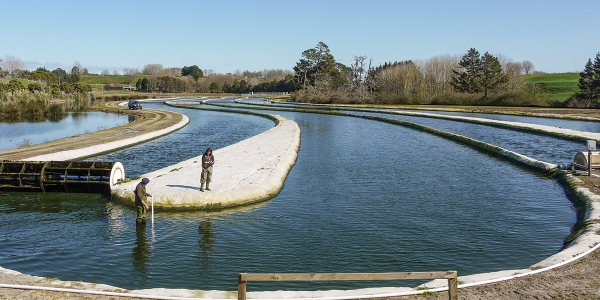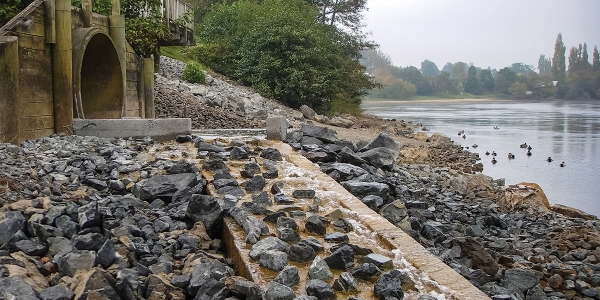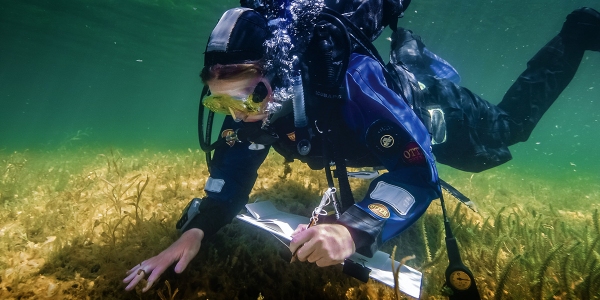Returning water to our waterways after we’ve used it in our homes, on farms and in industry is a complex and challenging process.
Large centres have traditionally employed mechanical treatment systems to clean up wastewater. These systems are able to process large volumes, but the flipside is that they are expensive to build and have high operational costs.
For smaller centres, that’s a problem. Oxidation ponds have been the go-to solution for small and medium-sized communities for the past 30 years. Relatively cheap to build and easier to maintain, these work well at removing suspended solids and lessening biochemical oxygen demand. But the problem is they’re highly inconsistent when it comes to removing pathogens and nutrients.
NIWA has been working to take the pond concept to the next level, with work on developing and improving smaller scale, eco-tech wastewater treatments.
“Oxidation ponds have been a great workhorse for New Zealand,” says Dr Rupert Craggs, Principal Scientist - Aquatic Pollution. “But now our aspirations for water quality are so much higher.”
NIWA and the Waipa District Council are working together to demonstrate the use of enhanced pond systems to achieve cost-effective, efficient wastewater treatment. At the Cambridge wastewater treatment plant, the use of two one hectare shallow ponds has been shown to maximise algal productivity and nutrient removal.
Given the system requires a comparatively large land area to work, smaller communities with land available stand to gain most. And, as well as the land requirement, there’s another variable—the sunlight that fuels the processes involved in cleaning up wastewater.
“Because it’s a natural system reliant on sun-driven power, the caveat is that there can be variation with seasonal conditions,” says Craggs. “Our focus is now on designs to take this into account, and considering additional treatment elements.”
But what of water quality? Can a natural wastewater treatment system trump a mechanised plant?
“A natural system can be designed to perform as well as a mechanised system, and better in some cases. There’s also the co-benefit of recovering resources from the wastewater (such as bio-gas) as well as providing treatment.”
Toxic mix
In the early 20th century, coal miners used canaries in mines as an early-warning signal for the dangerous build-up of toxic gases.
The birds, being more sensitive to toxic gases than humans, would develop symptoms of carbon monoxide poisoning well before the miners, who would then have a chance to take action to protect themselves. Technology has advanced a long way since then, but bioassays—measures of how potent a substance is by its effect on living cells or tissues—continue to be a critical measure of the impact of contaminants on various environments.
In NIWA’s freshwater ecotoxicity testing work, a range of organisms including invertebrates, fish and algae, are exposed to different concentrations and combinations of contaminants in laboratory conditions to gauge response.
“This allows us to establish thresholds for short-term lethal exposure, for example, to longer term sub-lethal impacts on lifecycles,” says Dr Chris Hickey, NIWA Principal Scientist - Ecotoxicology and Environmental Chemistry.
“The key thing is that it provides solid numeric data on how much (contamination) is too much and the diagnostic tools needed for toxicity identification.”
While testing informs the development of water quality guidelines, one of ecotoxicology’s greatest values is in its application to monitor the impact of specific stressors in site-specific situations. It is increasingly being used to provide reliable information to industries trying to meet their resource consent requirements under the Resource Management Act. That is no surprise given how New Zealand’s vast network of waterways are subject to a wide range of usages and resulting stressors. Freshwater is used in commercial, industrial, residential and recreational situations, and waterways can be affected by multiple contaminants from many different sources.
“There isn’t a one-size-fits-all (test) for all environments,” says Hickey. “Bioassays using both standard and native species tests complement other biological monitoring techniques used to establish the health of New Zealand’s aquatic ecosystems”.
Free passage
Tide gates stop fish from accessing 1100km of waterways in the Waikato River catchment. Thousands more kilometres are made inaccessible by other structures such as culverts, weirs and dams.
Nationwide, there are likely tens of thousands of structures in our rivers, with between 30% and 50% of these structures impeding migration of fish in some way. The result is fewer fish in our rivers.
NIWA Freshwater Ecologist Dr Paul Franklin sees the problem first-hand in his work.
“We see fish massing by human barriers, trying to continue their upstream movements. A few make it past, but many do not. Some will find alternative habitats, but many are eaten. You often see shags collecting fish below the barriers.”
Some native fish are more affected by migration barriers than others. Inanga (Galaxias maculatus), the main whitebait species, are weak swimmers and cannot climb. They are highly susceptible to being blocked by in-stream structures. However, koaro (G. brevipinnis) and juvenile eels (Anguilla australis and A. dieffenbachii) are very good climbers and can even make their way past waterfalls. Franklin says the good news is that there is almost always a way of building new structures in a more fish-friendly way, and to retrofit existing structures to allow more fish past.
“We helped design and install a rock fish ramp and baffles where the Bankwood (Kukutaruhe) Stream was piped into the Waikato River in Hamilton. Within a year, the number of fish species upstream of the culvert had doubled and there are now many more fish in the stream.”
Providing fish passage is required by law and many regional regulations. The Tasman District Council has recently made it mandatory to fix fish passage at all existing culverts.
“We’ve known the importance of providing fish passage for decades, but designing effective fish passes for our native fish has been challenging,” Franklin says.
“A big problem has been the gap between ecologists and engineers, but we’re now doing a better job of speaking the same language.”
NIWA and DOC are currently drafting fish passage guidelines that will help policymakers and engineers with the best methods of constructing fish-friendly structures. NIWA is part of a national advisory group leading the development of new resources to improve management of fish passage.
A new research project just underway will improve understanding of how and why fish behave at structures. This will help us do an even better job of building fish-friendly structures in the future.
Flipping lakes
As freshwater storage and supply sources, New Zealand’s lakes serve as critical gauges of the overall health of many water catchments and ecologies.
There’s good news and bad news in what these gauges are revealing, says NIWA Chief Science Advisor Dr Clive Howard-Williams.
“While about one-third of our monitored lakes are ranked good or very good, and one-third are ranked moderate in terms of ecosystem health, we have a long way to go to restore the one-third that are ranked poor or very poor. Most of these are in lowland areas. There are some grounds for optimism in that over the past 10 years of monitoring, more lakes have shown improvements than have worsened.”
The introduction of pest fish species, aquatic weeds and nuisance algae had seriously undermined the ecological health of lakes.
“Aquatic weeds have impacted on the native vegetation of lakes in the high country as well as lowland New Zealand, and the lake edges, or littoral zones, have been most impacted,” says Howard-Williams.
“Pest fish such as koi carp and catfish prey on native species and in some cases have markedly contributed to declines in ecosystem health.”
Coastal lakes and the shallow lakes of the Waikato were in particularly bad shape.
“Lakes reflect land use in a catchment and can also modify downstream aquatic systems. The shallow lakes of the Waikato, for example, have suffered from excessive nutrient inflows from farming in their catchments and, in particular, from pest plants and fish that have significantly altered lake habitats.”
NIWA is working with a range of partners on a series of research programmes aimed at improving the health of New Zealand lakes, says Howard-Williams.
“NIWA is looking at improved catchment management where lakes are receiving waters in the catchment. Some of this is directly funded through the National Science Challenge ‘Our Land and Water’, which seeks to minimise environmental effects in an improving agricultural economy.”
[This feature appeared in Water & Atmosphere 18]
Previous article on Stepping into the river: Dairy turns the corner
Related information
- More freshwater and estuaries news
- Previous article on Stepping into the river: Dairy turns the corner
- Other Water & Atmosphere 18 features



